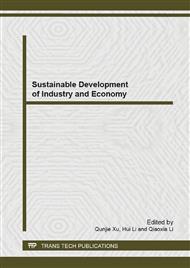p.750
p.754
p.758
p.762
p.766
p.773
p.777
p.781
p.786
Empirical Research on China's Environmental and Economic Development
Abstract:
This paper conducts a research with practical evidence by collecting 3 indicators of pollutants in 31 major cities in China for the period from 2003 to 2011, and analyzes the relationship between environmental quality and economic increase in China. In the paper, it proves the Environmental Kuznets Curve (EKC) theory. By comparing the turning points to those from other studies, it is found that the turning points of Chinas EKC are obviously lower than the other countries. In addition, the paper also makes comparisons among different cities in China, and studies the factors that trigger the turning points that characterize the environmental economic development in major cities in China. In the end, it is concluded that geographical factors, pollutant indicators, economic scales, industrial structure, technological treatments and government investments are major factors that cause the turning points to occur.Keywords: Economic Increase; Pollution Emission; Environmental Kuznets Curve; Environmental Turning Point.
Info:
Periodical:
Pages:
766-772
Citation:
Online since:
December 2013
Authors:
Price:
Сopyright:
© 2014 Trans Tech Publications Ltd. All Rights Reserved
Share:
Citation:


